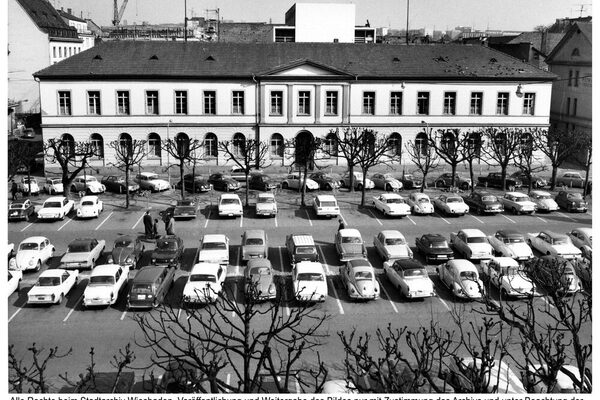Mints
Coins were minted in Wiesbaden from around 1350 until after 1400 (also in Sonnenberg), 1591-95 and 1830-66. Of the locations, only the classicist building on Luisenplatz is known.
The Walram line of the House of Nassau, to whose domain Wiesbaden belonged until 1866, was granted royal coinage privileges in 1329, 1354, 1367 and 1398. By the middle of the 14th century, a three-tier coinage system consisting of gold guilders, larger silver or groschen coins as well as pfennigs and hellers as the lowest tiers already existed. Counts Adolf I (1344-1371) and Ruprecht (1355-1390) of Nassau were the first to mint coins in Wiesbaden. The younger Ruprecht only owned the dominion of Sonnenberg and in 1367-77 half of Wiesbaden as a pledge. In 1368-79 the mint master Heinrich von Kratzau can be documented in Wiesbaden. In Idstein and Wiesbaden, Adolf I and his sons Gerlach and Walram minted pfennigs on the Würzburg strike, as was customary on the Middle Rhine, and heller; in Idstein also gold guilders, Ruprecht in Sonnenberg and Wiesbaden gold guilders, heller and pfennigs and Count Adolf II (1393-1426) pfennigs with the clear mention of Wiesbaden.
When, after 1570, increasingly large quantities of inferior small change were struck in the Upper Rhine Imperial Circle, to which the Nassau counts of the Walram line belonged, Count Johann Ludwig zu Nassau-Wiesbaden (1568-1596) joined in and opened a mint in Wiesbaden, where he struck gold florins, thalers and thick double thalers from the taler die and particularly large quantities of half-bats (2 kreuzers) and bowl-shaped pfennigs. The ban on half-bats by the Imperial Diet of 1594 deprived the Wiesbaden mint of its livelihood, led to the closure of the mint and to an Imperial Chamber Court case against the Count. Unsuccessful efforts to revive the mint in Wisbaden are documented from the years 1618 and 1650, followed in 1747 by a project to establish a mint in Biebrich.
After the Duchy of Nassau was founded in 1806, it took over the former Electorate of Trier mint in Ehrenbreitstein and expanded it. In addition to a few ducats, convention money and small change made of poor silver and copper were minted there. Convention money takes its name from an Austro-Bavarian convention of 1753, which established a new thaler weighing one tenth of a Cologne mark (around 233.8 g) of fine silver. In 1815, Nassau ceded Ehrenbreitstein to Prussia and moved the mint to the former Franciscan monastery in Limburg, which is now the episcopal ordinariate. In 1828, the technically obsolete Limburg mint, which had produced ducats, crown thalers based on the Austrian-Dutch model and small change, was closed.
In Wiesbaden, the new building on Luisenplatz, which went into operation in 1830, was equipped with the modern toggle presses developed by Diederich Uhlhorn in Grevenbroich in 1817 and an 8 hp steam engine a few years after minting began, thus meeting the technical requirements of a modern mint at the time. After 1838, Nassau minted coins of the South German Mint Association of 1837, which initiated the monetary unification of Germany. The Dresden Coinage Treaty of 1838 was followed by "association coins" of 3 ½ southern German guilders or two northern German talers, and after the Vienna Coinage Treaty of 1857 also of "association talers" as the next step towards unification. The Wiesbaden mint also produced money for the Principality of Birkenfeld (1840, 1848) and Hohenzollern-Sigmaringen (1840-47), which were in personal union with Oldenburg. After the annexation of Nassau, the Wiesbaden mint was closed in 1866.
Literature
Isenbeck, Julius: Das nassauische Münzwesen, Münster 1970 (reprint).
Schneider, Konrad: Die Münzstätte Wiesbaden - um 1350 bis 1866. In: Albert, Rainer: Die Münzstätten Mainz und Wiesbaden. Festschrift der Numismatischen Gesellschaft Mainz-Wiesbaden von 1821 e.V. zum 38. Süddeutschen Münzsammlertreffen, Speyer 2003 [pp. 85-99].
Schneider, Konrad: The coinage in the Duchy of Nassau, Höhr-Grenzhausen 2005.
